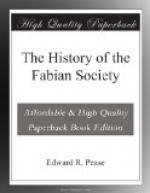The tracts published in these years included a series of “Questions” for candidates for Parliament and all the local governing bodies embodying progressive programmes of administration with possible reforms in the law—which the candidate was requested to answer by a local elector and which were used with much effect for some years—and a number of leaflets on Municipal Socialism, extracted from “Facts for Londoners.” In 1891 the first edition of “What to Read: A List of Books for Social Reformers,” classified in a somewhat elaborate fashion, was prepared by Graham Wallas, the fifth edition of which, issued as a separate volume in 1910, is still in print. “Facts for Bristol,” drafted by the gentleman who is now Sir Hartmann Just, K.C.M.G., C.B., was the only successful attempt out of many to apply the method of “Facts for Londoners” to other cities.
It is impossible for me to estimate how far the Progressive policy of London in the early nineties is to be attributed to the influence of the Fabian Society. That must be left to the judgment of those who can form an impartial opinion. Something, however, the Society must have contributed to create what was really a remarkable political phenomenon. London up to 1906 was Conservative in politics by an overwhelming majority. In 1892 out of 59 seats the Liberals secured 23, but in 1895 and 1900 they obtained no more than 8 at each election. All this time the Progressive Party in the County Council, which came into office unexpectedly after the confused election in 1889 when the Council was created, maintained itself in power usually by overwhelming majorities, obtained at each succeeding triennial elections in the same constituencies and with substantially the same electorate that returned Conservatives to Parliament.
In the early nineties the Liberal and Radical Working Men’s Clubs of London had a political importance which has since entirely disappeared. Every Sunday for eight months in the year, and often on weekdays, political lectures were arranged, which were constantly given by Fabians. For instance, in October, 1891, I find recorded in advance twelve courses of two to five lectures each, nine of them at Clubs, and fifteen separate lectures at Clubs, all given by members of the Society. In October, 1892, eleven courses and a dozen separate lectures by our members at Clubs are notified. These were all, or nearly all, arranged by the Fabian office, and it is needless to say that a number of others were not so arranged or were not booked four or five weeks in advance. Our list of over a hundred lecturers, with their subjects and private addresses, was circulated in all directions and was constantly used by the Clubs, as well as by all sorts of other societies which required speakers.




